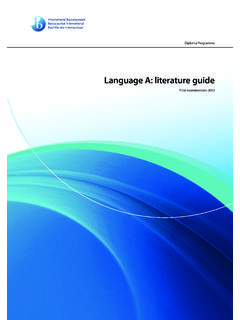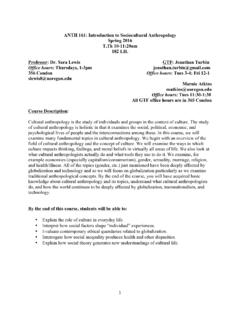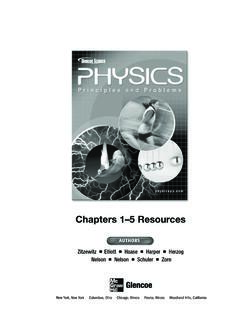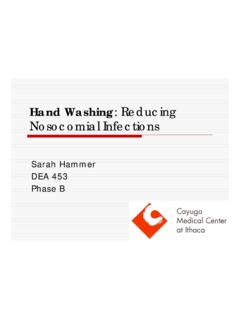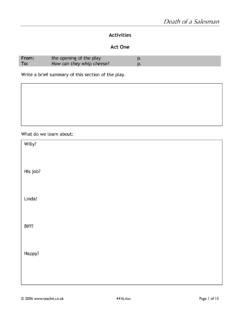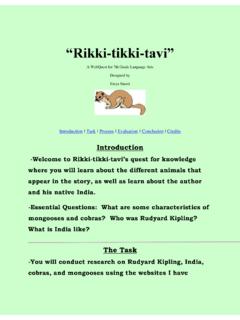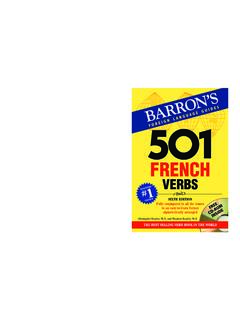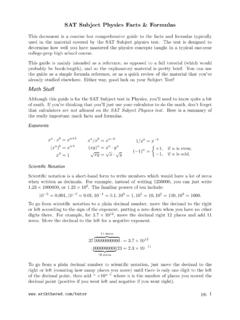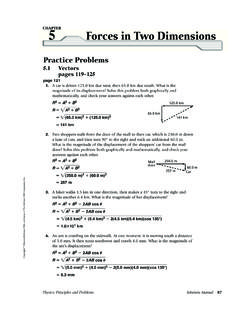Transcription of Chapters 21–25 Resources
1 Zitzewitz Elliott Haase Harper HerzogNelson Nelson Schuler ZornChapters 21 25 ResourcesA Glencoe ProgramStudent EditionTeacher Wraparound EditionTeacher Chapter ResourcesMini Lab WorksheetsPhysics Lab WorksheetsStudy guide Section QuizzesReinforcementEnrichmentTransparen cy MastersTransparency WorksheetsChapter AssessmentTeacher Classroom ResourcesTeaching Transparencies Laboratory Manual, Student Edition Laboratory Manual, Teacher EditionProbeware Laboratory Manual, StudentEditionProbeware Laboratory Manual, TeacherEditionForensics Laboratory Manual, StudentEditionForensics Laboratory Manual, TeacherEditionSupplemental ProblemsAdditional Challenge ProblemsPre-AP/Critical Thinking ProblemsPhysics Test Prep: Studying for the End-of-Course Exam, Student EditionPhysics Test Prep: Studying for the End-of-Course Exam, Teacher EditionConnecting Math to PhysicsSolutions Manual TechnologyAnswer Key MakerExamView ProInteractive ChalkboardMcGraw-Hill Learning NetworkStudentWorks CD-ROMT eacherWorks siteCopyright by The McGraw-Hill Companies, Inc.
2 All rights reserved. Permission is granted to reproduce the material contained herein on the condition that such material be repro-duced only for classroom use; be provided to students, teachers, and families without charge; and be used solely in conjunction with the physics : Principles and Problemsprogram. Any other reproduction, for use or sale, is prohibited without prior written permission of the all inquiries to:Glencoe/McGraw-Hill8787 Orion PlaceColumbus, Ohio 43240 ISBN 0-07-865906-XPrinted in the United States of America1 2 3 4 5 6 7 8 9 045 05 04 03 02 01 00iiiChapters 21 25 ResourcesTo the Teacher ..ivChapter 21 Resources ..1 Chapter 22 Resources ..35 Chapter 23 Resources ..69 Chapter 24 Resources ..103 Chapter 25 Resources ..137 Teacher guide and Answers ..171 ContentsCopyright Glencoe/McGraw-Hill, a division of The McGraw-Hill Companies, the TeacherCopyright Glencoe/McGraw-Hill, a division of The McGraw-Hill Companies, Lab and physics Lab Worksheets:Theseworksheets are expanded versions of the Mini Labsand physics Labs that appear in the five StudentEdition Chapters supported in this book.
3 All mate-rials lists, procedures, and questions are repeatedso that students can complete a lab in most caseswithout having a textbook on the lab table. Datatables are enlarged so they can be used to easilyrecord data, and all lab questions are reprintedwith lines on which students can write theiranswers. For student safety, all appropriate safetysymbols and caution statements have been repro-duced on these pages. Answer pages for each MiniLab and physics Lab Worksheet are included in theTeacher guide and Answers section at the back ofthis ANDINTERVENTIONS tudy guide :These pages help your students learnphysics vocabulary and concepts. study Guideworksheets typically consist of six pages of ques-tions and exercises for each of the five Student Edi-tion Chapters supported in this book. Items arepresented in a variety of objective formats: match-ing, true/false, interpreting diagrams and data,multiple choice, short-answer questions, and soon. The first study guide worksheet for each chap-ter reviews vocabulary.
4 Subsequent worksheetsclosely follow the organization of the textbook,providing review items for each textbook sectionand references to specific will find the study guide worksheetshelpful for previewing or reviewing chapter mate-rial. As a preview, the worksheets help studentsfocus on the concepts at the time you assign thereading. Students can complete each study Guidesection after reading the corresponding textbooksection. Some students will have more successcompleting the sheets in smaller chunks. For thisreason, the question sets on the study guide pagesare referenced to specific readings in the complete, these worksheets will prove to bean excellent review instrument. Answers to theStudy guide pages are included in the TeacherGuide and Answers section at the back of : These pages provide opportunitiesthat complete your teaching cycle and benefit allyour students. Reinforcement masters are espe-cially helpful for students who require additionalinstruction in order to understand certain con-cepts.
5 A Reinforcement master is provided for eachof the five Student Edition Chapters supported inthis book. Answers to these pages are included inthe Teacher guide and Answers section at the backof this :These activities offer students thechance to apply physics concepts to new situa-tions. Students explore high-interest topics in avariety of formats. Some of the masters are hands-on activities. An Enrichment master is provided foreach of the five Student Edition Chapters supportedin this book. Answers to these pages are includedin the Teacher guide and Answers section at theback of this book contains Resources that support five Student Edition Chapters of physics : Principles and worksheets and activities have been developed to help you teach these Chapters more effectively. Youwill find in chapter order:continuedTo the TeachervCopyright Glencoe/McGraw-Hill, a division of The McGraw-Hill Companies, Transparency Masters and Activities:These transparencies relate to major concepts thatwill benefit from an extra visual learning aid.
6 Mostof the transparencies contain art or photos thatextend the concepts put forth by those in the text-book. Others contain art or photos directly fromthe Student Edition. There are 120 Teaching Trans-parencies. The ones that support these five StudentEdition Chapters are provided here as black-and-white masters accompanied by worksheets thatreview the concepts presented in the transparen-cies. Teaching Tips for some transparencies andanswers to all worksheet questions are provided inthe Teacher guide and Answers section at the backof this Quiz: The Section Quiz page consists ofquestions or problems that focus on key contentfrom one section of the Student Edition. Each quiztypically includes conceptual items that require awritten response or explanation and items thatrequire problem-solving skills or mathematical cal-culations, where applicable. The Section Quizoffers representative practice items that allow youto monitor your students understanding of thetextbook.
7 Answers to each Section Quiz are pro-vided in the Teacher guide and Answers section at the back of this Assessment: The Chapter Assessmentpages provide materials to evaluate your students understanding of concepts and content from thefive Student Edition Chapters supported in thisbook. Each test consists of six pages of material,which is divided into three sections. Understanding physics Concepts requires students to demonstrate their knowledge of vocabulary and other basic information presented in the chapter. They are assessed through a variety of question types, including matching, modified true/false, short answer/fill-in, and multiple choice. Thinking Critically requires students to use higher-order learning skills. Students will need to interpret data and discover relationships presented in graphs and tables. Other questions may require them to apply their understanding of concepts to solve problems, compare or contrast situations, andmake inferences or predictions.
8 Applying physics Knowledge consists of itemsthat assess students ability to extend their learning to new situations. Assessment is done qualitatively through short-answer questions, and quantitatively through problems. The questions and problems in thissection are more difficult than those presented earlier and generally require more calculations as well as a deepercomprehension of chapter ANDANSWERSA nswers or possible answers to all worksheet ques-tions and activities can be found in order ofappearance at the back of this book. Criteria foracceptable answers are found where FieldsMini Lab Worksheet ..3 physics Lab Worksheet ..5 Chapter 21 study guide ..9 Section Quiz ..15 Section Quiz ..16 Reinforcement ..17 Enrichment ..19 Teaching Transparency Masters and Worksheets ..21 Chapter 21 Assessment ..29 Reproducible Pages Contents1 Copyright Glencoe/McGraw-Hill, a division of The McGraw-Hill Companies, FieldsTie a pith ball on the end of a 20-cm nylon thread and tie the other end to a plastic straw.
9 Holding the straw horizontally, notice that the ball hangs straight down. Now rub a piece of wool on a 30-cm 30-cm square of plastic foam to charge both objects. Stand the foam vertically. Hold the straw and touch the pith ball to the will happen when the ball is close to the prediction by slowly bringing the hanging ball toward the charged plastic ball s behavior at different locations around the foam, and test your angle of the thread as you move the pith ball to different regions around the and Conclude ,in terms of the electric field, why the ball swings toward the charged plastic? angle of the thread at various points around the foam. Why did it change? the angle of the thread indicates about the strength and the direction of the : Principles and ProblemsChapters 21 25 Resources321 Mini Lab WorksheetCHAPTERC opyright Glencoe/McGraw-Hill, a division of The McGraw-Hill Companies, of CapacitorsA capacitor is an electric device that is made from two conductors, orplates, that are separated by an insulator, and is designed to have a specific capacitance.
10 The capacitance depends on the physical characteris-tics and geometric arrangement of the conductors and the insulator. Inthe circuit schematic, the capacitor appears to create an open circuit, evenwhen the switch is in the closed position. However, because capacitorsstore charge, when the switch is closed, charge from the battery will moveto the capacitor. The equal, but opposite charges on the two plates withinthe capacitor establishes a potential difference, or voltage. As charge isadded to the capacitor, the electric potential difference increases. In thislaboratory activity you will examine the charging of several do the charging times of different capacitors vary with capacitance?Objectives Collect and organizedata on the rate of charge of different capacitors. Compare and contrastthe rate of charging for different capacitances. Make and use graphsof potential difference versus time for : Principles and ProblemsChapters 21 25 Resources521 physics Lab WorksheetCHAPTERM aterials 9-V battery 9-V battery clip hook-up wires switch voltmeter 47-k resistor stopwatch capacitors: 1000 F, 500 F, 24 0 FCopyright Glencoe/McGraw-Hill, a division of The McGraw-Hill Companies, you begin, leave the switch open (off).
